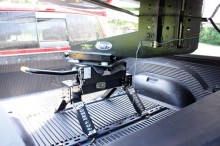Top Tips to Avoid a Wreck
When it comes to towing, people seem most concerned with whether they’ll have enough power for pulling?—?they shouldn’t be. Suffice it to say that most modern gas and diesel engines have more than enough horsepower to handle manufacturers published tow weights.
What they should be concerned about is braking. Why? While acceleration is a controlled event?—?braking often isn’t. Have you ever heard the expression “emergency acceleration”? Of course not?—?however we’ve all heard of “emergency braking”; and it’s during those panicked moments that several tons of hurtling mass must be precisely controlled to avoid disaster.

What often compounds braking emergencies is the fact that we don’t tow all the time, yet we expect our rigs to handle the same whether hooked up or not. They can, but only if the driver remembers that trailers, (even though they have independent brakes) will push the tow vehicle during braking, not only magnifying the load on the truck’s brakes but also increasing the risk of fishtailing, a jackknife, or brake fade and a subsequent loss of control. All this has to be allowed for, and that means that the driver AND the truck must be just as ready to tow.
So, assuming that the truck and trailer are loaded within their published capacities how do you ensure a safe controlled stop? That answer has four mechanical parts:
1) The truck brakes need to be maintained and working correctly.
2) The truck must be equipped with a trailer brake controller. This is either an integrated factory installed unit or an aftermarket one married to the vehicle’s braking system. This has the truck and trailer brakes working in unison. It must also be regularly calibrated?—?then checked to make sure it’s working!
3) Trailer brakes must be checked and maintained on a similar schedule to that of the truck’s brakes. They don’t last forever; and they often require manual adjustment.
4) The truck’s transmission and engine braking device (if so equipped) are also part of the overall braking system and the operator should understand how to use them effectively and use them often.
Moving past the mechanical, the most important component of a braking system is the driver. Yes, the human element; and that is the real wild card isn’t it? So what do you have to do besides stepping on the brake pedal? Quite a bit actually.
Banish Your Control Issues!
1) Double all distances. Double following distances; double merge spaces; double stopping distance when towing.

2) Have a weather eye. Heat, cold, wet, icy, day, night, visibility —?each condition and combinations of each require a different braking style?—?and this means the driver must anticipate; not react.
3) Practice! Use the tow vehicle engine’s natural exhaust resistance to slow the combination. Try exiting the highway and guess how much distance will be required for the rig to roll to a stop at the end of the off-ramp without applying the brakes?— when you get good at this you’ll have gained a real “seat-of-the-pants” feel for your truck/trailer combination.
4) Consider adding mechanical aids to your tow vehicle to aid in stopping. Bolt-on aftermarket engine braking devices can increase stopping power.
5) Use your transmission?—?whether your truck is a standard or an automatic. Selecting a lower gear on grades will increase resistance that will smoothly hold your trailer back (but be aware the added strain translates into extra heat, so a transmission cooler is a smart investment).
6) Never allow a trailer combination to coast in neutral. The rule is: if you’re not in gear, you‘re not in control.

Graph Explained:?The “rule of thumb” is to have the controller set to a number that will assertively stop the trailer?—?without locking up the brakes. A low number is no safer than a high number as the need for that number is directly related to the weight of the trailer and load.
WARNING:?You don’t want to be over a 10. Also, the Trailer?/?Tow Vehicle Configuration should never be set high enough to lock up the trailer brakes. Skidding trailer wheels can cause loss of control of the trailer and tow vehicle.
Notes:?Vehicle weight is listed on the door sticker. Horse trailers have a registration plate that lists dry weight and gross weight (weight of trailer plus capacity).
The Trailer?/?Tow Vehicle Configuration number is only a recommendation based on the weights of your trailer and tow vehicle. Other factors, such as number of axles, brake type, brake wear, etc., affect your braking performance. Adjust the Trailer?/?Tow Vehicle Configuration setting as necessary to achieve the desired aggressiveness.
This chart is provided courtesy of Hensley Hitch. Hensley suggests that if your tow vehicle is the same weight or lighter than your trailer then please consider purchasing a Hensley Arrow to eliminate trailer sway.
